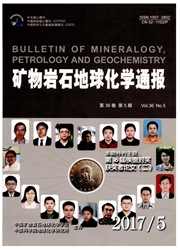

 中文摘要:
中文摘要:
为研究兰州市2005年冬季大气可吸入颗粒物(PM10)中单颗粒的矿物组成,用能谱扫描电镜识别和统计了兰州市区(东方红广场)和郊区(榆中县)两个采样点的单矿物颗粒。结果在市区样品中识别出方解石、伊/蒙混层、石英、斜长石、伊利石、石膏、绿泥石、高岭石、浊沸石和钾长石等21种矿物,前7种占统计总量的75%以上;郊区样品中识别出20种矿物,以方解石、石英、伊利石、绿泥石、斜长石和伊/蒙混层为主(占70%以上),与市区相比缺少钾石膏、金红石和水铝酸钙而增加了硫酸镁和磷灰石。总体来看,大气PM10中的矿物颗粒可分为粘土类、长石类、碳酸盐类、硫酸盐类、氧化物类和其他六类,以粘土类和碳酸盐类矿物为主(约占60%);冬季市区颗粒物表面的“硫化”现象较郊区严重;这些矿物颗粒主要来自地表土,人为排放和大气中二次化学反应生成的矿物的贡献较小。
 英文摘要:
英文摘要:
SEM/EDX is applied to investigate mineral compositions of the individual particles in the inhalable particulate matter (PM10) collected in Lanzhou urban area (Dongfanghong square) and suburb (Yuzhong County) in the winter, 2005. The results show that there are 21 types of minerals, in the urban samples including calcite, illite and smectite mixed layers, quartz, plagioclase, illite, gypsum, chlorite, kaolinite, laumontite, K-feldspar, with the dominant (over 75%) minerals being calcite, illite/smectite, chlorite, quartz, plagioclase, illite, gypsum and chlorite. There are 20 types of minerals in the suburban samples, with the dominant (over 70%) minerals being calcite, quartz, illite, chlorite, plagioclase and illite/smectite. Comparing with the samples collected in urban area, the samples collected in suburb contain no syngenite, rutile and calcium aluminate but magnesium sulfate and apatite. These minerals belong to clay, feldspar, carbonate, sulphate, oxide minerals, with dominant minerals of clay and carbonate. It is indicated that the surface of particles in urban area was more seriously sulfurated than that of the particles in suburb in winter. The inhalable particles in the urban area and suburb were originated mainly from soil-derived dust.
 同期刊论文项目
同期刊论文项目
 同项目期刊论文
同项目期刊论文
 Associations between particle physicochemical characteristics and oxidative capacity: An indoor PM10
Associations between particle physicochemical characteristics and oxidative capacity: An indoor PM10 期刊信息
期刊信息
